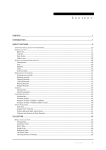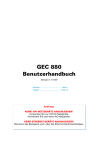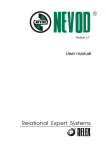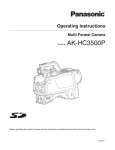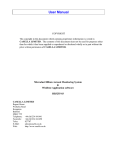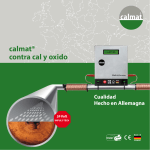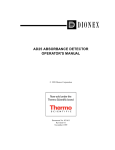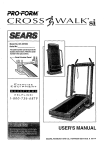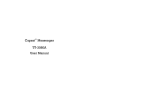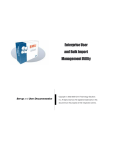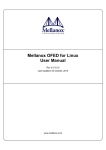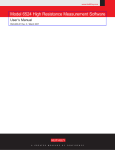Download Users Guide
Transcript
Users Guide
ATEX-TETRA-Hand-held Radio
BHR 21 IS
Copyright notice in compliance with DIN ISO 16016
GA_BHR_PMRS_001_eng.doc
© PMRS GmbH
Date of print : 04.12.2006
Page1 / 49
ATEX-TETRA-Handheld Radio BHR 21 IS
History
EVers.:
01
02
03
04
Date
18.05.06
09.06.06
04.12.06
14.06.07
Author
HF
E-fr
Udo A.
Udo A.
Change and Reason
Revision 2006
Editorial review
PMRS Adaptation
Review Additional notes
Status
Draft
Release
Release
Release
© 2004 - 2006 PMRS GmbH
PMRS GmbH
Tränkeweg 5
15517 Fürstenwalde
Telefon: + 49 30 2000 36212
Fax: + 49 30 657 62 480
Copyright notice in compliance with DIN ISO 16016
GA_BHR_PMRS_002_eng.doc
© PMRS GmbH
Page 2 / 49
ATEX-TETRA-Handheld Radio BHR 21 IS
Contents
1 General.........................................................................................................................................5
1.1 Additional Safety Instructions ..............................................................................................6
1.2 Initial operation ....................................................................................................................6
1.3 Directions for maintenance..................................................................................................7
2 Disposal .......................................................................................................................................8
2.1 Rechargeable Batteries .......................................................................................................8
2.2 Product Disposal .................................................................................................................8
3 Charging the Rechargeable Battery..........................................................................................9
3.1 Charging in the Single-Unit Charging Device ....................................................................10
3.2 Charging with the Travel Charging Device ........................................................................10
3.3 Charging in the Multi-Unit Charging Device ......................................................................10
4 Switching On/Off the Hand-held radio Set .............................................................................11
5 Controls of the BHR 21 IS ........................................................................................................12
5.1 Layout of the Controls .......................................................................................................12
5.2 Connectors ........................................................................................................................13
5.3 Connecting Audio Accessories..........................................................................................13
5.4 Illuminated Ring (LED) ......................................................................................................14
5.5 Keypad ..............................................................................................................................14
5.6 Rotary Switches.................................................................................................................15
5.6.1 Select Group Switch (FS1).......................................................................................................... 15
5.6.2 Volume Control (FS2).................................................................................................................. 15
5.7 Function Keys/Buttons.......................................................................................................16
5.7.1 Send Button PTT (FT2) ............................................................................................................... 16
5.7.2 Programmable Function Button 1 (FT1)...................................................................................... 17
5.7.3 Function Button 3 (FT3) .............................................................................................................. 17
5.7.4 Function Button 4 (FT4) .............................................................................................................. 17
5.7.5 Softkeys Left (FT5) and Right (FT9) ........................................................................................... 17
5.7.6 M/OK Key (FT6) .......................................................................................................................... 18
5.7.7 Scroll Up/Down Keys (FT7 and FT8) .......................................................................................... 18
5.7.8 Escape/Clear Key (FT10)............................................................................................................ 19
5.7.9 Emergency Call Button................................................................................................................ 19
5.8 Key Lock............................................................................................................................19
6 Display .......................................................................................................................................20
6.1 Brightness Control .............................................................................................................20
6.2 Display Structure ...............................................................................................................20
6.3 Icon Area ...........................................................................................................................21
6.4 Menu System.....................................................................................................................22
6.4.1 General Structure ........................................................................................................................ 22
6.4.2 Submenus ................................................................................................................................... 23
7 Volume Control .........................................................................................................................24
7.1 Direct Volume Control .......................................................................................................24
Copyright notice in compliance with DIN ISO 16016
GA_BHR_PMRS_002_eng.doc
© PMRS GmbH
Page 3 / 49
ATEX-TETRA-Handheld Radio BHR 21 IS
7.2 Volume Menu ....................................................................................................................24
7.3 Signal Tone Volume Control..............................................................................................24
8 Miscellaneous Device Settings................................................................................................25
8.1 Operating Mode / Select Network......................................................................................25
8.2 Call Parameters.................................................................................................................26
8.3 Date – Time .......................................................................................................................27
8.4 Language...........................................................................................................................27
8.5 Factory Settings.................................................................................................................27
8.6 Mute...................................................................................................................................27
8.7 Volume ..............................................................................................................................27
9 Individual Voice Calls ...............................................................................................................28
9.1 Simplex and Duplex Transmissions ..................................................................................28
9.2 Call Setup Variants............................................................................................................28
9.3 Entering the Call Destination via the Keypad ....................................................................29
9.4 Call Setup ..........................................................................................................................30
9.5 Using the Phonebook ........................................................................................................30
9.6 Redialling...........................................................................................................................31
9.7 Using the Calling List and Called List ................................................................................31
9.8 Accepting Incoming Voice Calls ........................................................................................32
9.9 Connection Status .............................................................................................................32
9.10 Terminating the Connection ............................................................................................33
10 Group Calls..............................................................................................................................34
10.1 General............................................................................................................................34
10.1.1 Group Calls, Selected Group .................................................................................................... 34
10.1.2 Scan Lists, Multigroups ............................................................................................................. 34
10.1.3 Selecting a Group, Scan Properties.......................................................................................... 35
10.2 Establishing a Group Call ................................................................................................36
10.3 Connection Status ...........................................................................................................36
11 Status Calls and Text Messages ...........................................................................................38
11.1 Receiving Status Calls and SDS .....................................................................................38
11.2 Reviewing Status Calls and SDS via the Menu System..................................................39
11.3 Transmitting a Status Call ...............................................................................................40
11.3.1 Transmitting a Pre-programmed Status Call............................................................................. 40
11.3.2 Transmitting a Status Number................................................................................................... 41
11.4 Transmitting a Text Message (SDS) ...............................................................................42
12 Technical Data.........................................................................................................................43
12.1 General technical data.....................................................................................................43
12.2 Technical data: Transmitter .............................................................................................43
12.3 Technical data: Receiver .................................................................................................43
12.4 Technical data: Battery pack ...........................................................................................43
13 Marking ....................................................................................................................................44
14 Scope of delivery ....................................................................................................................45
15 Notice .......................................................................................................................................45
Copyright notice in compliance with DIN ISO 16016
GA_BHR_PMRS_002_eng.doc
© PMRS GmbH
Page 4 / 49
ATEX-TETRA-Handheld Radio BHR 21 IS
1 General
The BHR 21 IS Hand-held radio set you acquired is a high-quality tool for radio communication in
professional digital TETRA radio communications networks. It complies with all the requirements for
operation in explosive areas.
These operating instructions describe the functions and user interface of the radio set. They will be
updated according to the latest software version and can be obtained from the manufacturer as
required.
In some topics of these operating instructions you will find references to various operational variants
that depend on "preprogramming" or "personalization" of the radio set. This refers e.g. to the setting
of the radio communications network parameters, functional variants and user-specific parameters
(Phonebook, group list etc.).
Note
)
Caution
Caution
Please read the commissioning and operating instructions
supplied with each BHR 21 IS radio set before using it.
These instructions provide all the relevant and mandatory safety
instructions, information on operating conditions and service
information.
The classification of hazardous areas according to zones in
compliance with 1999/92EC is the responsibility of the user, on
whose premises hazards of this kind exist or may arise or
whose work involves or may involve such hazards.1
Within the scope of the European directive 99/5/EC, the
operator must ensure that the health protection and safety of the
user of the terminal equipment and of other persons is
guaranteed.2
Caution
With respect to the exposure of people to electromagnetic fields
(110 MHz to 40 GHz), product standard EN 50385 must be
applied.
1
2
In compliance with directive 94/9/EC amendment I, item 1.0.6
In compliance with article 3 (1)a of 99/5/EC and 1999/519/EC)
Copyright notice in compliance with DIN ISO 16016
GA_BHR_PMRS_002_eng.doc
© PMRS GmbH
Page 5 / 49
ATEX-TETRA-Handheld Radio BHR 21 IS
1.1 Additional Safety Instructions
The BHR 21 IS meets the requirements of the ATEX –standard / Protection class
II 2 G EEx ib IIC T4 as well as II 3D T130°C IP54.
You must not operate the device in areas that may be subject to metallic dust.
The EC-TYPE-EXAMINATION CERTIFICATE number is ZELM 06 ATEX 0319 X
A copy of the certificate is enclosed within the attachments and is to be considered.
Operate the BHR 21 IS with the battery pack BHR 21 IS (55000759), only then operating the device is
admissible.
Do not recharge the battery within EX-zones (hazardous areas).
Changing the battery in EX-zone is always allowed.
Use the BHR 21 IS only if the antenna is undamaged and tightly screwed to the device.
You must not remove the antenna within EX-zones.
Exchanging the device’s accessories in areas that might be subject to explosive dusts is not allowed.
The accessory connector on top of the device has to be shut by the sealing plug coming with the
device or any other plug of an accessory that has been certificated by the manufacturer.
You must only use accessories for the device which have been certificated by the manufacturer for
this purpose.
Do not use solvents or any other liquid substances for cleaning the device.
If any of these directions are not taken into consideration, operating the BHR 21 IS is not permitted.
Changes to the device’s case are not admissible. If device or battery is damaged, the device has to
be taken out of service. Same goes for lack damage to battery or face plate >2cm2.
The battery must not be disassembled or discarded into fire.
Device and battery are to be taken out of service in case of malfunction or mechanical defect
immediately. They are to be marked and removed from EX-zones.
Repairs may only be performed by the manufacturer (see page 2 for address). For further questions
please contact your local vendor or the manufacturer.
1.2 Initial operation
Charge the Li Ion battery before the initial operation of the hand-held radio. You may charge the
battery itself in a single or multiple charger as well as in combination with the radio.
At first you will have to apply the battery to the device by clicking it into the battery retainer. Now you
can switch on the hand-held radio.
Operation of portable radio types BHR 21 IS need to be prepared and programmed before usage.
Network and all other specific parameters for trunked mode operation (TMO) and/or direct mode
operation (DMO) need a specific configuration for each radio which is related to actual regulations of
Copyright notice in compliance with DIN ISO 16016
GA_BHR_PMRS_002_eng.doc
© PMRS GmbH
Page 6 / 49
ATEX-TETRA-Handheld Radio BHR 21 IS
the relevant network operator and all relevant regulations within the country of use including
frequency regulations. Though firmware and software are included the radio has to be programmed
for specific use by the means of the delivered personalisation tool originally manufactured and
delivered from PMRS GmbH while setting all network relevant data, numbers, group assignments and
other features. Personalisation must be conducted by authorized personnel or service partners who
have been trained by PMRS GmbH and are able to show a valid authorisation certificate originally
issued from PMRS GmbH. Loading of Firmware must be conducted while the battery is already fully
charged.
Besides the battery the enclosed antenna is an essential part for accurate use of the radio. Operation
of the radio must be executed while the antenna is fixed to the radio in the designated position to the
antenna connector of the radio. Wetness, humidity and impurification of both the antenna connector of
the radio and the antenna itself may cause severe damage or usage problems of the radio. It has to
be assured that both connectors are dry and clean before fixing them to each other.
There is a leather carrying bag available fort he BHR 21 IS. This bag has been especially developed
for use in EX-zones and is part of the device’s ATEX-certificate. The BHR 21 IS may be used as well
as with or without this carrying bag in such areas. Only certificated carrying bags may be used for this
purpose.
1.3 Directions for maintenance
The device is free of maintenance.
Note the storage conditions of the battery. A battery that has been left uncharged for a long period will
permanently loose capacity. Therefore it should be recharged before a long period of storage. Before
reaching the storage limit a battery has to be fully dis- and then recharged, thus the it stays functional
and the storage limit has been reset.
Operating temperature
Transport temperature
Storage temperature
-20 °C...+55 °C
-40 °C...+70 °C
(short time)
--20 °C...+60 °C max. one month (without recharge)
-20 °C...+45 °C max. three month (without recharge)
-20 °C +25 °C max. one year
(without recharge)
Copyright notice in compliance with DIN ISO 16016
GA_BHR_PMRS_002_eng.doc
© PMRS GmbH
Page 7 / 49
ATEX-TETRA-Handheld Radio BHR 21 IS
2 Disposal
2.1 Rechargeable Batteries
This device is operated with a battery containing harmful substances. The battery must not be
disposed of in your domestic refuse. After the service life of the battery has ended, it must be
disposed of either via a PMRS customer service centre or via an appropriate collection point.
Heed the relevant regulations for environmental protection and disposal in the country of use.
2.2 Product Disposal
The products identified with the following icon are subject to the requirements of the
German ElektroG Act.
The ElektroG Act combines the requirements of the following EC directives:
• 2002/96/EC (WEEE) for electric and electronic equipment wastes
• 2002/95/EC for restricting the use of specific hazardous substances in
electronic equipment (RoHS directive).
Once the service life of a product has ended, this product must not be disposed of in
the standard domestic refuse. Even disposal via the municipal collection points for electric and
electronic wastes is not permitted.
In favour of an environmentally-friendly disposal or recycling of matters, PMRS GmbH has developed
a disposal concept and fully assumes the duty of taking back and disposing of electric and electronic
wastes according to the ElektroG Act on behalf of the manufacturer.
Please revert to your local service representative or directly to PMRS GmbH to dispose of the
product.
Contact:
PMRS GmbH
Aussenstelle Berlin
Köpenicker Straße 325 Haus 201
12555 Berlin
Tel. +49 30 6576 2480
Fax +49 30 6576 2480
Copyright notice in compliance with DIN ISO 16016
GA_BHR_PMRS_002_eng.doc
© PMRS GmbH
Page 8 / 49
ATEX-TETRA-Handheld Radio BHR 21 IS
3 Charging the Rechargeable Battery
Please ensure that your rechargeable battery is always charged to guarantee the reliability of your
radio set at all times and the operability whenever required.
Caution
Caveat emptor
The warranty does not include damage caused by charging the
rechargeable battery using charging devices of third-party manufacturers.
Æ Exclusively use the charging devices designed for the product.
The rechargeable battery can be charged via the power supply interface of the radio set when
inserted, or it can be charged separately. Since the rechargeable battery can be changed rapidly and
easily, a BHR 21 IS Hand-held radio set can also be kept in permanent operation.
When you remove the rechargeable battery from the radio set while it is switched on, the last settings
you made may be lost. For this reason, switch off the radio set before you remove the battery.
Push down the two locks (see figure to the right) to remove the battery.
The battery can then easily be folded out to the rear and removed to the
top. Analogously, for fitting the battery, first insert it into the bottom part
of the Hand-held radio set and then press at the top until it engages.
Thereafter you can switch on the Hand-held radio set.
Copyright notice in compliance with DIN ISO 16016
GA_BHR_PMRS_002_eng.doc
© PMRS GmbH
Page 9 / 49
ATEX-TETRA-Handheld Radio BHR 21 IS
3.1 Charging in the Single-Unit Charging Device
The single-unit charging device provides the
possibility of charging the battery separately
or installed in the Hand-held radio set. For this
purpose, the complete radio set or the battery
must be placed into the single-unit charging
device as shown in the figures to the right.
A lit red LED indicates that the charging
device is ready for operation. The yellow LED
is permanently lit while the battery is being
charged.
After the battery has been charged by approx.
95 %, the yellow LED will go out. A flashing
yellow LED indicates a fault or abort of the
charging
operation
due
to
excess
temperature.
The single-unit charging device is available as
a separate piece of accessory.
3.2 Charging with the Travel Charging Device
The rechargeable battery can be charged directly via a travel
charging device. For this purpose, plug the connector of the
charging device into the charging socket on the bottom side of the
BHR 21 IS.
The charging operation is indicated through a pulsating battery icon
in the header of the display. As soon as the charging process has
been completed, the icon of the full battery is displayed.
3.3 Charging in the Multi-Unit Charging Device
The functions and handling of the multi-unit charging correspond to
those of the single-unit charging device.
Copyright notice in compliance with DIN ISO 16016
GA_BHR_PMRS_002_eng.doc
© PMRS GmbH
Page 10 / 49
ATEX-TETRA-Handheld Radio BHR 21 IS
4 Switching On/Off the Hand-held radio Set
The BHR 21 IS Hand-held radio set is switched on by pressing the
Escape/Clear key (key C) for an extended period of time (approx. two
seconds). When the Hand-held radio set is switched on, the background
lighting is activated as well. During the booting process, a start screen is
displayed for approx. 3 seconds. At the same time, the radio set will start
scanning for the digital TETRA radio communications network.
The antenna icon
flashes and the message "NETSEARCH“ will be
displayed.
After it has successfully registered in the radio network, the radio set is
ready for operation. The icons for field strength, the antenna icon (constant)
and the charging status of the battery are displayed.
The main field of the display indicating operational readiness displays the
name of the preprogrammed network with the device number. Underneath
it, the selected group or the preprogrammed clear text name ("group 12" in
our example) will be displayed.
If the radio set was in direct mode (DMO) when it was switched off, it will
return to direct mode as soon as it is switched on again. This is indicated
through the
icon in the display header.
Press the Escape/Clear key for at least two seconds to switch off the radio
set. The prompt "OFF?“ will be displayed. If this prompt is confirmed by
pressing the softkey "OK", the radio set will be switched off after a brief
deactivation time.
Copyright notice in compliance with DIN ISO 16016
GA_BHR_PMRS_002_eng.doc
© PMRS GmbH
Page 11 / 49
ATEX-TETRA-Handheld Radio BHR 21 IS
5 Controls of the BHR 21 IS
5.1 Layout of the Controls
The following overview shows the layout of
the controls and their standard functions.
Antenna
Emergency
button
FS 1: Select
group
Rotary switch
Soft end
Illuminated ring
call
FS 2: Volume
Rotary switch
Soft end
FT 1:
Programmable
Function button
FT 3:
Select group
Scroll up
FT 2:
Send button
(PTT,
Push-to-
FT 4:
Volume level
Scroll down
FT 5:
Left softkey,
Menu
FT 9:
Right softkey,
Phonebook
FT 6:
M/OK key,
Call acceptance
FT 10:
End of call,
Escape/Clear
FT 7 and 8:
Scroll Up/Down
Display
Keypad
Digit entry
Copyright notice in compliance with DIN ISO 16016
GA_BHR_PMRS_002_eng.doc
© PMRS GmbH
Page 12 / 49
ATEX-TETRA-Handheld Radio BHR 21 IS
5.2 Connectors
Audio socket with
cap
Antenna socket
for vehicle eceptacle
I/O connector
Charging socket
5.3 Connecting Audio Accessories
On the top of the BHR 21 IS Hand-held radio set there is a 4-pin socket for connecting acoustic
accessories such as microphone-loudspeakers, headphones, helmet headset etc. The connection
socket is equipped with a cap as a protection against soiling.
Caution
Caveat emptor
As a rule, only those accessories may be connected that have been
approved by the manufacturer of the radio set and that have ATEX
approval.
Æ Exclusively use the accessories designed for the product.
Never exert force when plugging or pulling the connector. The
mechanical coding of the socket and plug as well as the additional
colour coding must be observed. A snap-on contact prevents
accidental disconnection. Pull back the contact sleeve to
disengage the connection, then gently pull off the connector.
The radio set automatically detects plugged acoustic accessories.
The acoustic paths are automatically switched when the
accessories are connected/disconnected. A sequence of three
tones signals the detection and switchover acoustically.
Copyright notice in compliance with DIN ISO 16016
GA_BHR_PMRS_002_eng.doc
© PMRS GmbH
Page 13 / 49
ATEX-TETRA-Handheld Radio BHR 21 IS
Volume settings made for acoustic accessories are stored separately and automatically re-activated
when the accessories are used again. This feature facilitates different volume settings for the radio
set loudspeaker and the accessories.
You can use the PTT (push to talk) button on the accessories, or you can use the PTT button of the
radio set (will remain in operation).
5.4 Illuminated Ring (LED)
On the top of the BHR 21 IS Hand-held radio set there is a colour display in a ring at the bottom of
function button FS1 (select group switch). The different colour displays are to support the user
especially during voice connections when only the top of the device is visible due to the way it is
carried.
Description of the colour codes:
Green
Flashing
yellow
Red
Red + green
Reception
Call signal, incoming call (ring tone)
Authorization to talk, transmission
Duplex mode active (telephone mode)
5.5 Keypad
The twelve-key, alphanumeric standard key pad is used for a context-sensitive input of digits, and in
the text message editor also for letters and special characters.
Copyright notice in compliance with DIN ISO 16016
GA_BHR_PMRS_002_eng.doc
© PMRS GmbH
Page 14 / 49
ATEX-TETRA-Handheld Radio BHR 21 IS
5.6 Rotary Switches
Neither rotary switch on the top of the radio set features a mechanical stop. Once the limit position
has been reached, a reject tone is output when an attempt is made to turn the switch any further.
The following designations refer to the corresponding main function:
5.6.1 Select Group Switch (FS1)
Turn the Select Group switch (FS1) to jump to the list of all groups that
are available in the current multi-group (group profile). In this list, you
can turn the Select Group switch further to shift the selection line by
line depending on the direction, in which you turn the switch.
FS1
Once a group has been selected, press the M/OK key (FT6) to
determine this group as your own selected group.
Confirming your selection with the PTT button initiates the setup of a
group call to the selected group without registering this group as the
selected group.
FS 2
5.6.2 Volume Control (FS2)
Turn the volume control (FS2) to directly change the volume of the radio set loudspeaker. The volume
control menu will be displayed. Further turning will increase/decrease the volume further.
Copyright notice in compliance with DIN ISO 16016
GA_BHR_PMRS_002_eng.doc
© PMRS GmbH
Page 15 / 49
ATEX-TETRA-Handheld Radio BHR 21 IS
5.7 Function Keys/Buttons
In this context, all the function keys/buttons will be described that are not part of the twelve-key
standard keypad.
5.7.1 Send Button PTT (FT2)
The various tasks of the send button PTT (push to talk) depend on the respective functional status of
the radio set.
5.7.1.1 Status: Ready for Operation
When the radio set is ready for operation, pushing of the PTT button
sets up a group call to the (own) selected group. In this status, the
number or designation of this group is displayed in the bottom display
line. If a group has not been selected, it is not possible to establish a
group call simply by pushing the PTT button. Instead, a reject tone will
be output.
5.7.1.2 Active Simplex Connection
During an active simplex connection in a group call or individual call,
pushing of the PTT button signals the desire to talk over this connection.
The PTT button must be kept pushed. Once the permission to send has
been granted, a short tone will be output to indicate "ready to send", i.e.
you can talk.
Release the PTT button to stop sending.
5.7.1.3 Active Duplex Connection
The PTT button does not have any function during an active duplex
connection.
5.7.1.4 Input Confirmation
After a subscriber number has been entered via the keypad, selected in the phonebook,
selected in the calling list or called list or after having selected a group in the Groups menu,
the PTT button can be used to confirm your input and send the corresponding connection
request to the infrastructure. Depending on the default call settings3 the PTT button either
triggers a direct call with automatic call acceptance on the receiver side, or an individual
simplex call with manual hook signalling (for individual calls in each case).
5.7.1.5 Call Acceptance
An individual call coming in with ring tone can be accepted by pushing the PTT button.
3
Please also refer to: Menu → Settings → Call parameters.
Copyright notice in compliance with DIN ISO 16016
GA_BHR_PMRS_002_eng.doc
© PMRS GmbH
Page 16 / 49
ATEX-TETRA-Handheld Radio BHR 21 IS
5.7.2 Programmable Function Button 1 (FT1)
The FT1 button has not been assigned any function yet (default).
5.7.3 Function Button 3 (FT3)
5.7.3.1 Direct Access to the Group List
When the radio set is ready for operation, pressing function button FT3 will open the list of all
the groups programmed in the selected multi-group and assigned dynamically. This function
corresponds to that of rotary switch FS1.
5.7.3.2 Cursor Up in the Menu
Within the open menu system, function button FT3 is used for stepwise scrolling up the line
selection (scroll up).
5.7.4 Function Button 4 (FT4)
5.7.4.1 Direct Access to the Volume Menu
When the radio set is ready for operation, pressing function button FT4 will open the menu for
controlling the volume of the radio set loudspeaker.
5.7.4.2 Cursor Down in the Menu
Within the open menu system, function button FT4 is used for stepwise scrolling up the line
selection (scroll down).
5.7.5 Softkeys Left (FT5) and Right (FT9)
The respective function of the left-hand softkey (FT5)
and right-hand softkey (FT9) is indicated in the fields
above the softkeys in the footer of the display.
When the radio set is ready for operation (see figure),
the left-hand softkey is used to open the menu
system and the right-hand softkey is used to open the
phonebook.
Context
Softkey
Context
Softkey
In the menus for controlling the volume and the brightness, the left-hand softkey (FT5) is used for
decreasing and the right-hand softkey (FT9) for increasing the selected parameter.
Copyright notice in compliance with DIN ISO 16016
GA_BHR_PMRS_002_eng.doc
© PMRS GmbH
Page 17 / 49
ATEX-TETRA-Handheld Radio BHR 21 IS
5.7.6 M/OK Key (FT6)
The various tasks of the M/OK key depend on the respective functional status of the radio set. For
menu entries, this key is used for final confirmation of the input or for saving the selected setting.
5.7.6.1 Re-Dialling
When the radio set is ready for operation, pressing the M/OK key displays the subscriber
number called last. The desired connection is then established via the M/OK key or the PTT
button.
5.7.6.2 Input Confirmation/Call Setup
After a subscriber number has been entered via the keyboard, after a subscriber number has
been selected in the phonebook or in Called List or Calling List, call setup to this number is
initiated by pressing the M/OK button. Depending on the default call setting4, the OK key either
triggers an individual simplex call with mandatory manual hook signalling, or a duplex call (for
individual calls in each case).
5.7.6.3 Input Confirmation/Select Group
After a group has been selected in the Groups menu, this group is determined as the selected
group via the M/OK key.
5.7.6.4 Call Acceptance
An individual call coming in with ring tone can be accepted by pushing the PTT button.
5.7.7 Scroll Up/Down Keys (FT7 and FT8)
5.7.7.1 Direct Brightness Control
When the radio set is ready for operation, the scroll keys are used for directly controlling the
brightness of the display. A menu is not displayed for this purpose.
5.7.7.2 Cursor Functions
When the menu system is open and when lists are displayed, the scroll keys are used to
select lines. The possibility of scrolling is indicated by icons above the scroll keys in the violet
field in the footer of the display.
4
Please also refer to: Menu → Settings → Call parameters
Copyright notice in compliance with DIN ISO 16016
GA_BHR_PMRS_002_eng.doc
© PMRS GmbH
Page 18 / 49
ATEX-TETRA-Handheld Radio BHR 21 IS
5.7.8 Escape/Clear Key (FT10)
Depending on the function status of the radio set, the Escape/Clear key or delete key is used for the
following purposes:
• Switching on the device by pressing the key for an extended period of time
• Terminating an existing individual call connection
• Deletion of the last input, or of the entire input when pressing the key for an extended
period of time
• Return to the superordinate (previous) menu level
• Switching off the device by pressing the key for an extended period of time.
EMERGENCY
CALL
5.7.9 Emergency Call Button
To trigger an emergency call, the emergency call button must be pressed for at least one second.
The type of emergency call made depends on the default device configuration.
The following emergency calls are possible: voice calls in the form of group calls or individual calls,
calls to telephone subscribers or the transmission of an emergency call status to a group or an
individual subscriber.
5.8 Key Lock
Pressing the hash key three times enables a key lock. The enabled key lock
is indicated in the header of the display with a lock icon.
When a key is pressed while the key lock is enabled, a corresponding
message will be displayed.
Only the emergency call button, the volume control and the hash key are
still effective when the key lock is enabled. The hash key must be pressed
three times again to unlock the keys.
Copyright notice in compliance with DIN ISO 16016
GA_BHR_PMRS_002_eng.doc
© PMRS GmbH
Page 19 / 49
ATEX-TETRA-Handheld Radio BHR 21 IS
6 Display
6.1 Brightness Control
When the radio set is ready for operation, the scroll keys are used for directly
controlling the brightness of the display. A menu is not displayed for this purpose.
The menu system can also be used to change the
brightness. Proceed as follows to do so:
Menu → 6 Settings → 7 Volume and then continue with
keys FT7 and FT8 for switchover.
The current brightness value will be displayed in percent
and can be changed via the softkeys.
6.2 Display Structure
The display is subdivided into three areas:
Header with function icons
Main display field
Footer, context of the softkeys
When entering the menu system, the header displays the name
of the respective menu. Once you are in the menu system, the
available submenus are displayed in the main display field in the
form of a list. These can be selected using the scroll keys or by
entering the leading line number. Confirm your selection by
pressing the respective softkey.
In all the display formats, the footer always displays the contextsensitive functions of the softkey as as well as the available
scrolling or browsing options.
Copyright notice in compliance with DIN ISO 16016
GA_BHR_PMRS_002_eng.doc
© PMRS GmbH
Page 20 / 49
ATEX-TETRA-Handheld Radio BHR 21 IS
6.3 Icon Area
At the upper edge of the display area, icons indicate the current operating status. The following table
provides an overview of the icons used and a corresponding description.
Icon
flashing
Description
Network scan
In the network (registered)
Field strength
flashing
Incoming duplex call
Duplex connection active
flashing
Incoming simplex call
Simplex connection active
Battery charging status, in the form of a ticker during charging,
flashes if a temperature fault occurs during charging
Direct mode switched on
flashing
Message received (reading not acknowledged with OK)
Key lock enabled
Air Interface Encryption enabled
Receive during voice call
Transmit during voice call
8:34
Time
Copyright notice in compliance with DIN ISO 16016
GA_BHR_PMRS_002_eng.doc
© PMRS GmbH
Page 21 / 49
ATEX-TETRA-Handheld Radio BHR 21 IS
6.4 Menu System
6.4.1 General Structure
When the radio set is ready for operation, the "Menu" softkey can be used to switch to the menu
system. Use the scroll keys to select a submenu and confirm the selection with the "OK" key.
▼
Press the “PhoneB” softkey to switch to the default telephone directory and directly set up a call in this
directory.
Copyright notice in compliance with DIN ISO 16016
GA_BHR_PMRS_002_eng.doc
© PMRS GmbH
Page 22 / 49
ATEX-TETRA-Handheld Radio BHR 21 IS
6.4.2 Submenus
For the time being, the menu system provides the following submenus:
Menu:
1 SDS
2 Called list*)
3 Calling list*)
4 Groups
5 Multigroups
6 Settings
7 Information
Second menu level
Lists of sent and received text messages and status calls
List of the last incoming calls
List of the last calls made
List of groups of the selected multigroup with display of the priority for
scanning and listening in
List of several combined groups (group profiles)
List of various settable parameters and operating modes that can be
selected on the next menu level:
1 Operating mode
2 Call Parameters
3 Date - Time
4 Language
5 Factory settings (reset to default values)
6 Mute (loudspeaker is switched off)
7 Volume
The Information menu item displays the following user data. They cannot
be selected nor changed.
• CH
(current channel)
• RSSI (current receive field strength)
• ISSI (subscriber number of the Hand-held radio set)
• MCC (country code of the TETRA network)
• MNC (network code of the TETRA network)
• VCC (current voltage at the rechargeable Lithium ion battery)
▼..▼
*) These menu items are hidden until calls have come in / calls have been made.
Copyright notice in compliance with DIN ISO 16016
GA_BHR_PMRS_002_eng.doc
© PMRS GmbH
Page 23 / 49
ATEX-TETRA-Handheld Radio BHR 21 IS
7 Volume Control
7.1 Direct Volume Control
The volume can be controlled directly via rotary switch FS2. In this case, the
volume of voice and tone signals are changed proportionally. While the volume is
being controlled, the current value is displayed.
7.2 Volume Menu
When using the rotary switch FS2 or when pressing function button FT4 on
the right-hand side of the radio set, the volume control menu is directly
displayed. The value displayed can be changed either via rotary switch FS2
or via the softkeys FT5 and FT9 below the display.
The volume control menu can also be accessed via the general menu
system as follows: Menu → Settings → Volume.
7.3 Signal Tone Volume Control
Signal tones are output to support operation, as a response to operator actions, when the device
status changes, when messages arrive and for call processes. They are used as a confirmation,
rejection or as a note/alarm.
The most frequent signals:
• Signal for registering in the TETRA network (TMO) or for network scan
• Availability (release) of the voice channel and device ready to send (confirmation of the
channel assignment with the PTT button pressed)
• Call signals for individual voice calls in simplex and duplex mode, end of a connection,
call rejection
• Status call or text message transmitted or received
• Fault signal, low battery warning.
The volume of the signal tones can be set separately:
In the volume menu (Menu: "Volume LSP“) you can use the scroll keys FT7
and FT8 below the display to switch to another menu for changing the
signal tone volume relative to the overall volume.
The value can be changed either via the softkeys or rotary switch FS2. The
display will automatically return to the standard operating display (ready for
operation) when no further are made (timeout).
Copyright notice in compliance with DIN ISO 16016
GA_BHR_PMRS_002_eng.doc
© PMRS GmbH
Page 24 / 49
ATEX-TETRA-Handheld Radio BHR 21 IS
8 Miscellaneous Device Settings
Menu "6 Settings“ provides the following device settings for selection and change.
▼..▼
8.1 Operating Mode / Select Network
The "Operating Mode“ menu item offers the possibility of switching between the operation in different
networks and operation in direct mode on different frequencies. This feature depends on the default
options of the radio set.
In the example to the right, one TETRA network "gasnet“ and two direct
mode configurations, DMO1 and DMO2 can be selected.
After you have selected the desired network using the scroll keys and
confirmed your selection with the "OK“ softkey, the radio set will switch to
the selected configuration.
Copyright notice in compliance with DIN ISO 16016
GA_BHR_PMRS_002_eng.doc
© PMRS GmbH
Page 25 / 49
ATEX-TETRA-Handheld Radio BHR 21 IS
8.2 Call Parameters
The parameters for outgoing voice calls that can be set via the "Call parameters“ menu item depend
on the default functions of your Hand-held radio set. The call parameters that can be changed for
handling individual voice calls can be displayed and changed in Menu → Settings→ Call parameters.
Default setting 1:
PTT button → Simplex call
M/OK key → Duplex call
Choice between automatic (direct call) and
manual (hook signalling) call acceptance on the
side of the called subscriber.
Default setting 2:
PTT button → direct call
M/OK key → telephone mode (ring tone)
Choice between duplex
individual voice calls.
and
simplex
for
When the menu is called, the currently set value is displayed first. When you acknowledge this value
with "OK“, a prompt for making a change, if desired, will be displayed. Once the change has been
confirmed, the new call setting will be displayed.
Copyright notice in compliance with DIN ISO 16016
GA_BHR_PMRS_002_eng.doc
© PMRS GmbH
Page 26 / 49
ATEX-TETRA-Handheld Radio BHR 21 IS
8.3 Date – Time
The date and time are always displayed as additional information for the
detailed display in the called list, calling list and the list of incoming status
calls and text messages. The time is also displayed in the header of the
display.
To make this function available, the date and time must be entered after the
radio set has been switched on.
After selecting Menu → 6 Settings → 3 Date - Time, enter the data via the
keypad and save them with OK.
8.4 Language
The menu path Menu → 6 Settings → 4 Language displays the menu for
selecting the language of the user interface.
8.5 Factory Settings
If you confirm the "Factory settings“ menu item, all the manual settings you made will be reset to the
factory defaults.
8.6 Mute
When "Mute" is confirmed, the loudspeaker is switched off. As of this time,
neither signal tones nor voice will be heard since the loudspeaker is
disabled. This setting may be of interest if only status and text messages
are to be used in very noisy environments, or if mute operation is desired.
The loudspeaker can be enabled again in the same menu. Before the
loudspeaker is switched off, you have to confirm a prompt with OK.
8.7 Volume
Menu → 6 Settings → 7 Volume displays the menu for volume control. Use the scroll keys below the
display to switch to the menu for changing the volume of signal tones and to the menu for changing
the display brightness. Menus can also be called directly and values can be changed directly via the
rotary switch and the function buttons/keys (refer to 5.6.2, 5.7.4.1 and 5.7.7.1).
Copyright notice in compliance with DIN ISO 16016
GA_BHR_PMRS_002_eng.doc
© PMRS GmbH
Page 27 / 49
ATEX-TETRA-Handheld Radio BHR 21 IS
9 Individual Voice Calls
As opposed to group calls that reach a group of subscribers with a single call, individual voice calls
are established by dialling the number of a single subscriber.
9.1 Simplex and Duplex Transmissions
In simplex mode, voice data are always transmitted in only one of two possible directions. The desire
to send voice data (i.e. to talk) is transmitted to the network infrastructure via the PTT button, which
then grants the radio set the permission to send. In this context, the network controller may treat the
radio communications subscribers with different priorities when granting the permission to send.
Dispatcher terminals, for example, are often processed with a higher priority.
In a duplex mode connection, both the radio sets can transmit and receive permanently. If a call is
established to the PSTN through a specific prefix, the call is automatically established in duplex
mode.
9.2 Call Setup Variants
•
•
It is possible to set defaults for the radio set that provide for the setup of a direct call when a
call is initiated via the PTT button. In the case of a direct call, the receiver need not actively
accept the call. The called radio set will automatically switch to the receive status.
If the same radio set is used to initiate the call via the M/OK key (FT6), the receiver must
accept the call after the ring tone just as in the case of a standard telephone (hook mode).
Alternatively the radio set can be programmed with default values that cause every individual
voice call initiated with the PTT button to be set up in simplex mode and each call initiated with
the M/OK key (FT6) to be set up in duplex mode (refer to 8.2 Call parameters).
Copyright notice in compliance with DIN ISO 16016
GA_BHR_PMRS_002_eng.doc
© PMRS GmbH
Page 28 / 49
ATEX-TETRA-Handheld Radio BHR 21 IS
9.3 Entering the Call Destination via the Keypad
In standard operating status (ready for operation), an individual voice call is made by entering the
subscriber number via the keypad and then pressing either the PTT button or the M/OK key (refer to
8.2 Call parameters).
When the first digit is entered, ISSI is displayed in the top line to indicate
that an individual subscriber number is entered. Faulty inputs can be
deleted by pressing the Escape/Clear key briefly, or, if complete inputs are
to be deleted, by pressing it for an extended period of time.
When all the entered or preset digits have been deleted, "dial" will be
displayed in the top line as a prompt to enter a subscriber number. For radio
communication fleets with long subscriber numbers that differ only in the
last digit, the identical leading digits can be pre-programmed in the radio for
ease of operation. When entering digits via the keypad, the preprogrammed leading digits will then automatically be prepended. If a
completely different subscriber number is to be called, these automatically
prepended digits must first be deleted.
A connection to the PSTN is always set up in duplex mode. In the radio set,
a specific prefix made up of one, two or three digits, e.g. "00" is pre-programmed as a feature. When this prefix is entered, the following digits
are interpreted as a subscriber number.
When entering this prefix, the display switches from "ISSI“ to "PSTN“ (public
switched telephone network) and the subscriber number entered is
displayed in the bottom line without the prefix previously entered (input in
our example: 00 12345).
The display returns to the standard operating display if no other input or confirmation is made within 5
seconds.
Copyright notice in compliance with DIN ISO 16016
GA_BHR_PMRS_002_eng.doc
© PMRS GmbH
Page 29 / 49
ATEX-TETRA-Handheld Radio BHR 21 IS
9.4 Call Setup
During call setup up to the automatic or manual call acceptance, the
handset icon (in duplex mode) or the radio set icon (in simplex mode) in the
header will flash.
Once the connection has been established, the respective icon will be
displayed permanently and the message "CALL ESTABLISHED" will be
displayed.
If the called subscriber answers when accepting the call, i.e. if he transmits,
the icon R for "Receipt" is displayed in the header and the illuminated ring
on top of the device is also lit in green.
9.5 Using the Phonebook
If the "PhoneB“ softkey is pressed when the radio set is ready for operation,
a telephone directory, i.e. a list of pre-programmed call destinations with the
associated names and subscriber numbers is displayed. The names are
displayed in the list. The desired destination can be selected via the scroll
keys or the rotary switch FS1 and the call can be transmitted by pressing
the PTT button or the M/OK key.
Press the "OK“ softkey to open the selected entry for editing.
When "OK“ is pressed again, the name and subscriber number of the
phonebook entry are displayed.
Copyright notice in compliance with DIN ISO 16016
GA_BHR_PMRS_002_eng.doc
© PMRS GmbH
Page 30 / 49
ATEX-TETRA-Handheld Radio BHR 21 IS
9.6 Redialling
When the M/OK key (FT6) is pressed in standard operating mode (ready for
operation) of the radio set, a menu for redialling is displayed. The
subscriber number dialled last (138 in our example) is displayed. If several
subscriber numbers have already been dialled and/or calls have already
come in, the menu footer offers direct access to the Called list ("OUT)
and/or to the Calling list ("IN") via the softkeys. In the lists, you can use
either a number you dialled earlier on or the number of a calling party for
redialling.
9.7 Using the Calling List and Called List
If the desired subscriber number has already been dialled after the radio set has been switched on, or
if this subscriber number has called your radio set, a corresponding call can be set up in the Called
list and Calling list submenus. The desired subscriber number can be selected using the scroll keys
(FT7 and FT8) or the rotary switch FS1. Then the call is transmitted via the PPT button or the "OK“ /
M/OK key (FT6). (also refer to Chapter 9.2)
If a subscriber listed in the Calling list is
called, the associated subscriber number /
name is deleted from the Calling list and
saved in the Called list instead.
The entries in the two lists can be deleted
via the Escape/Clear key (FT10).
While group calls are not saved in the
Calling list, the Called list also saves the
called groups.
Copyright notice in compliance with DIN ISO 16016
GA_BHR_PMRS_002_eng.doc
© PMRS GmbH
Page 31 / 49
ATEX-TETRA-Handheld Radio BHR 21 IS
9.8 Accepting Incoming Voice Calls
An incoming individual voice call is indicated through a call signal (ring
tone).
In addition, an incoming call is displayed as follows:
• Flashing radio set icon for a simplex call, or
• Flashing handset icon for a duplex call or telephone call, and
• The number of the calling party is displayed.
If the number is saved in the phonebook together with a name (Alias), the
corresponding name will be displayed instead of the subscriber number.
Individual calls can be accepted either with the PTT button or with the M/OK
key. If you accepted a call with the PTT button, you can talk at once as long
as you keep pushing the PTT button.
9.9 Connection Status
In an existing simplex connection, the desire to
talk must be signaled to the network infrastructure
by pressing the PTT button. If the call partner is
not transmitting, the permission to transmit is
granted almost immediately, which is signalled
acoustically through a short "blip".
The PTT button must be pressed for as long as
you want to transmit. The voice channel is
released when you stop pressing the PTT button.
While transmitting, a T (Transmit) on a red
background is displayed in the header of the
display, and while receiving, an R (Receive) with
a green background is displayed.
At the same time, the illuminated ring on the top
of the radio set lights up in the corresponding
colour.
Example 1: 132 has called 138, a connection
has been established in simplex mode. Top:
132 is transmitting; bottom: 138 is
t
itti
If the connected unit interrupts the transmission by releasing the PTT button, the green R icon in the
display will vanish and a short acoustic signal ("Roger beep") will indicate that the connection partner
can transmit.
Copyright notice in compliance with DIN ISO 16016
GA_BHR_PMRS_002_eng.doc
© PMRS GmbH
Page 32 / 49
ATEX-TETRA-Handheld Radio BHR 21 IS
In an active duplex connection, the two radio sets
transmit at the same time. The use corresponds
to that of mobile phones.
During this connection, the PTT button has no
function.
Example 2: 132 has called138, a duplex
connection has been established
9.10 Terminating the Connection
An individual voice connection is terminated by
pressing the Escape/Clear key (C-key).
Copyright notice in compliance with DIN ISO 16016
GA_BHR_PMRS_002_eng.doc
© PMRS GmbH
Page 33 / 49
ATEX-TETRA-Handheld Radio BHR 21 IS
10 Group Calls
10.1 General
10.1.1 Group Calls, Selected Group
The term group refers to a selected circle of radio communications subscribers, who are
characterized by an especially close, direct and frequently recurring, task-related communication
relationship. A group call is a voice call that reaches all the radio communications subscribers that
belong to the called group. In a group call, only one radio communications subscriber at a time may
transmit, while all the others receive. A group call can also be established when one or multiple
members of this group cannot be reached because they have another active connection or because
their radio set is switched off.
To facilitate the communication with the group, with the larger part of the
communication takes place, you have the possibility of selecting this group
as your own group in a pre-programmed list (Selected group). When the
radio set is ready for operation, this group is displayed in the bottom line of
the display. The selected group can be dialled simply by pressing the PTT
button.
10.1.2 Scan Lists, Multigroups
In addition to the selected group, each subscriber of a group may also belong to other groups, the
radio communication of which is also heard. The relationship to other groups, however, may be
handled with a different priority. For this purpose, a list of these groups has been pre-programmed in
the radio set. If a radio set is to be used for various applications, it must be possible to toggle
between different lists, i.e. between different multigroups.
In the TETRA radio communications network, the group list with the desired scan properties of each
group are aligned with the infrastructure upon switching on and logging in to the network. In this case,
it may be possible that the user is denied the membership of specific groups or that the radio
communications subscriber is assigned additional groups (dynamic groups). The assignment of
dynamic groups can also occur at any other point of time.
The current status of the scan list or of the groups with their properties in the selected multigroup can
be displayed in the menu system via the path Menu → 4 Groups and changed, if required. Each
change is aligned with the infrastructure.
Copyright notice in compliance with DIN ISO 16016
GA_BHR_PMRS_002_eng.doc
© PMRS GmbH
Page 34 / 49
ATEX-TETRA-Handheld Radio BHR 21 IS
10.1.3 Selecting a Group, Scan Properties
Turn the Select group switch FS1, press function button FT3 or use the
menu path: Menu → 4 Groups to open the list of groups that belong to the
currently selected multigroup (in this case: "GAS Admin“). In this submenu,
the header displays the pre-programmed designation for the selected
multigroup and below it all the groups with the registered scan priority. Nonpre-programmed, dynamically assigned groups may also be listed here.
A group may be assigned the following properties or scan priorities:
1 (S) Selected (scanned and selected group)
2 (L) Low priority (scanned with low priority)
3 (N) Normal priority (scanned with normal priority)
4 (H) High priority (scanned with high priority)
5 (-) Not scanned
6 (D) Detached (detached by User)
Press softkey FT5 (Edit) to open a Scan Priority submenu for the group
previously selected through scrolling and to select one of the properties
listed above.
Properties that may be displayed but that cannot be edited by the user:
(P)
(BL)
(BS)
(D1)
(D2)
(R)
(?)
Detach permanent (permanent disconnect by basic station)
SwMI locked (locked by basic station)
Always scanned (scanning cannot be disabled)
Detach temporary 1
Detach temporary 2
Detach Rejected
Not (yet) confirmed by infrastructure
If only "Group 12“ (selected in the above example ) is to be scanned and if "Group 11“ is to be
selected in the further process, this is possible directly by scrolling to group 11 in the list of groups
and then confirming your selection with the M/OK key.
Via the path Menu → 5 Multigroups you access the menu for replacing a
multigroup or scan list with another multigroup or scan list. Selection "1 No
group“ detaches all the groups. This means, there will be no participation in
group calls any longer, unless new groups are assigned dynamically by the
infrastructure.
Copyright notice in compliance with DIN ISO 16016
GA_BHR_PMRS_002_eng.doc
© PMRS GmbH
Page 35 / 49
ATEX-TETRA-Handheld Radio BHR 21 IS
10.2 Establishing a Group Call
Press the PTT button when the radio set is ready for operation to
immediately establish a group call to the group displayed in the bottom line
(in this case, "Group 12").
If a group call is to be established to a group other than the selected group,
this group must be selected in the Groups list. You can access this list via
the Select group rotary switch FS1 or by pressing function button FT3.
In the present example, we want to establish a call to the group "Dispo".
Once the group has been selected using the scroll keys or rotary switch
FS1, press the PTT button to initiate the group call. Note: in this case,
pressing the M/OK key would not result in call setup but would define the
group "Dispo" as the selected group.
10.3 Connection Status
During an active group connection, the name or
number of the called group will be displayed in the
top line of the display.
In the bottom line, first the initiator of the group
call is displayed and then the transmitting radio
communications subscriber with the associated
subscriber number or pre-programmed name.
Example: 132 has called the group "Dispo“
and is transmitting; 138 can see that 132 is
The desire to transmit must be signalled to the network infrastructure by pressing the PTT button. If
no other subscriber is transmitting at this time, a permission to transmit will be sent, indicated
acoustically by a short "blip". Keep pressing the PTT button for as long as you wish to transmit.
During the transmission, the T-icon (Transmit) on a red background is displayed. The illuminated ring
on the top of the radio set will also light up in red during the transmission.
The voice channel is released as soon as the PTT button is not pressed any longer. A "Roger beep"
is to be heard on the connected unit and the green R-icon (Receive) in the display of the receiving
side will go out. Then, another group call subscriber can transmit.
Copyright notice in compliance with DIN ISO 16016
GA_BHR_PMRS_002_eng.doc
© PMRS GmbH
Page 36 / 49
ATEX-TETRA-Handheld Radio BHR 21 IS
While a group connection is active, the infrastructure broadcasts information on the active group call
in short intervals. This gives every radio communications subscriber scanning this group and who
missed the beginning of the group call, the possibility of joining the group connection later on (Late
entry). This may be the case after leaving a radio shadow or after switching on the device.
If a radio communications subscriber wants to leave an active group connection, e.g. to establish
another call, he simply needs to press the Escape/Clear key (C-key). A group connection is
terminated either through inactivity (timeout) of all the connection subscribers or when the radio
communications subscriber, who initiated the group call, presses the C-key. These functions depend
on the settings in the radio communications network and may have been implemented differently
depending on the manufacturer of the infrastructure.
The end of a group call is displayed in the same way as that of an individual voice call.
Copyright notice in compliance with DIN ISO 16016
GA_BHR_PMRS_002_eng.doc
© PMRS GmbH
Page 37 / 49
ATEX-TETRA-Handheld Radio BHR 21 IS
11 Status Calls and Text Messages
In TETRA radio communications networks, you have the possibility of transmitting short messages in
the form of data telegrams without occupying a voice channel. In this case, status calls and text
messages or short data (SDS – Short data service) are distinguished. Status calls are transmitted as
a number. This requires that all the radio communications subscribers use the same information
content for the same status number. Generally, this information is pre-programmed in the radio sets.
Text messages (SDS) are free texts that are entered as an alphanumeric character string, i.e. in the
form of text, via the keypad and transmitted as such to the recipient. Status calls and text messages
may be sent to individual radio communications subscribers as well as to groups.
11.1 Receiving Status Calls and SDS
When receiving a status call or SDS, the
messages "State received“ or "SDS received“
as well as the number of the status call or - if
pre-programmed - the corresponding clear
message text (in this example: "Job is finished")
will be displayed.
The envelope icon will flash in the header.
When an SDS has been received, only the beginning of the text will generally be visible since the
complete text message cannot be displayed all at once.
Press the "Text“ softkey to open a new "Text" menu display. In this window the received status
messages or SDS can be read completely, including information on the subscriber number of the
transmitter and the date and time the message was received. Only when this open text window has
been acknowledged with the OK softkey will the flashing SDS icon (letter icon) be switched off in the
standard operating display of the radio set. The message is assumed read. The flashing SDS icon will
be reactivated as soon as a new message arrives.
Copyright notice in compliance with DIN ISO 16016
GA_BHR_PMRS_002_eng.doc
© PMRS GmbH
Page 38 / 49
ATEX-TETRA-Handheld Radio BHR 21 IS
11.2 Reviewing Status Calls and SDS via the Menu System
The navigation path "Menu → 1 (SDS) → 1 Received“ opens a list of
received status calls and SDS. After selecting the messages of
interest using the scroll keys and confirming your selection with the
"Text" softkey, the complete message text will be displayed. Our
example shows a long SDS.
The scroll bar on the right-hand side of the display means that the ▼
rest of the text, the time and the subscriber number of the text
message transmitter will become visible when scrolling. The
subscriber number of the text message transmitter is identified with
an exclamation mark.
When none of the messages in the list are of interest any longer, the
complete list can be deleted with the C-key.
Copyright notice in compliance with DIN ISO 16016
GA_BHR_PMRS_002_eng.doc
© PMRS GmbH
Page 39 / 49
ATEX-TETRA-Handheld Radio BHR 21 IS
11.3 Transmitting a Status Call
To transmit a status call, you first have to select the status call to be sent via the navigation path
SDS → Status.
11.3.1 Transmitting a Pre-programmed Status Call
If a status predefined in the selection list is confirmed with OK, a
submenu offers this status for transmission including its complete
text. Press the "back“ softkey to return to the selection menu for
status calls without transmitting the status call.
After confirming the status message with the "Send“ softkey, the
main menu is displayed again and you are prompted to enter the
destination. You can either enter the destination via the keyboard
or you can select a destination in the phonebook.
If the M/OK key is now pressed without having entered a
destination number, the status is transmitted to the subscriber
number you dialled last (enabling of the redialling function).
If the "Send“ softkey is pressed again without having entered a
call destination, the status is sent to your own group (the
"selected group").
Copyright notice in compliance with DIN ISO 16016
GA_BHR_PMRS_002_eng.doc
© PMRS GmbH
Page 40 / 49
ATEX-TETRA-Handheld Radio BHR 21 IS
11.3.2 Transmitting a Status Number
If you select "Input“ in the selection menu for status calls, an input menu for a freely selectable status
number (without programmed text context) is displayed. The status number to be sent is entered via
the numeric keypad. Upon confirmation with the "OK“ softkey, the main menu is displayed and a
prompt asks you to enter the call destination for the status message.
When entering the status number, take into consideration that only the
numbers in the range of from 32768 to 61439 are available for free use.
If you do not observe this restriction, a fault message like the one in the
figure to the right will be displayed.
Copyright notice in compliance with DIN ISO 16016
GA_BHR_PMRS_002_eng.doc
© PMRS GmbH
Page 41 / 49
ATEX-TETRA-Handheld Radio BHR 21 IS
11.4 Transmitting a Text Message (SDS)
An SDS is a text message that can be entered freely. To transmit a text message, first an editor
window is opened via the navigation path Menu "SDS“ and the "Edit SDS“. In this window, you can
enter the message via the keyboard.
The text is entered via the keypad. After pressing one of the
alphanumeric keys, an information line will appear in the lower
part of the display showing the character set available for the key
you just pressed. Use the *-key to toggle between upper-case
and lower-case letters as well as other special characters of the
character set..
For upper-case letters, the background of the information line is
yellow-orange, for lower-case letters green, and for special
characters red.
The input is confirmed with the "OK“ key. The menu will then
switch to the main display with the prompt to enter the destination
for the text message.
Once the call destination has been entered, the text message will be
sent as soon as you have confirmed your input with the "Send“
softkey.
Copyright notice in compliance with DIN ISO 16016
GA_BHR_PMRS_002_eng.doc
© PMRS GmbH
Page 42 / 49
ATEX-TETRA-Handheld Radio BHR 21 IS
12 Technical Data
12.1 General technical data
Operating temperature
Transport & Storage temperature
-20 °C...+55 °C
Hand-held radio
-20 °C...+60 °C
Battery
-20 °C...+60 °C max. one month
(without recharge)
-20 °C...+45 °C max. three month (without recharge)
-20 °C +25 °C max. one year
(without recharge)
IP 54
300-512MHz
6,25 / 12,5 / 25 kHz
simplex, semi duplex
π/4 DQPSK, frequency modulation, phasing modulation
V.24 LVTTL
Earphone
for active microphone loudspeaker
Protection class
Frequency range
Channel pattern, programmable
Transmission mode
Modulation type
1 Interface
1 Accessory interface
1 Accessory interface
12.2 Technical data: Transmitter
Meets following standard
Transmission power
Transmission lock-out
ETS 300 392-x; ETS 300 394-2-1; ETS 300 396-2 Part 2
max. 1 W
in accordance with thermal situation of hand-held radio
12.3 Technical data: Receiver
Meets following standard
ETS 300 392-x; ETS 300 394-2-1; ETS 300 396-2 Part 2
12.4 Technical data: Battery
Battery model
Power supply
Capacity
Operating temperature
Transport temperature
Storage temperature
Lithium-Ion
3,7V
ca. 3000 mAh
-20 °C...+55 °C
-40 °C...+70 °C
(short time)
-20 °C...+60 °C max. one month
(without recharge)
-20 °C...+45 °C max. three month (without recharge)
-20 °C +25 °C max. one year
(without recharge)
Copyright notice in compliance with DIN ISO 16016
GA_BHR_PMRS_002_eng.doc
© PMRS GmbH
Page 43 / 49
ATEX-TETRA-Handheld Radio BHR 21 IS
13 Marking
ZELM 06 ATEX 0319X
Marking of the ATEX -certificate
ZELM testing institute ZELM Ex Braunschweig
06
year of certificate
0319 certificate number
X
it indicates that the equipment is subject to special conditions for safe
use
Registering mark of devices and equipment for operating in hazardous areas
/ Ex-zones
II 2 G EEx ib IIC T4
II 3 D T130°C IP 54
0820
2007
Marking of protection class
II
Einsatz nur Übertage
2
category 2 = zone 1 = temporarily, potentially explosive atmosphere
G
gas protection class
EEx
marking of approval according to EC-directive 94/9/EC = ATEX
ib
the device is intrinsically safe
IIC
gas group IIC, gases with max. explosion hazard
T4
temperature class 4, max. temperature of device´s surface 135 °C
3
category 3 = zone 2 = intermittent hazardous atmosphere
D
dust protection class
T130°C max. temperature of device´s surface 130°C
IP54 protected against dust and water jets
The device meets european requirements and standards of ATEX handheld radios.
0820 is the number of testing institute ZELM Ex Braunschweig, that has
tested the production. Production year is 2007.
Once the service life of a product has ended, this product must not be
disposed of in the standard domestic refuse. Even disposal via the municipal
collection points for electric and electronic wastes is not permitted. Please
revert to your local service representative or directly to PMRS GmbH to
dispose of the product.
This product is made of components, which are a part of cycle of potential
recyclables. Please recycle it.
Note the user manual !
55000759
Order Number of battery BHR 21 IS
Copyright notice in compliance with DIN ISO 16016
GA_BHR_PMRS_002_eng.doc
© PMRS GmbH
Page 44 / 49
ATEX-TETRA-Handheld Radio BHR 21 IS
14 Scope of delivery
You get the ATEX-Hand-held radio BHR 21 IS with:
•
•
•
•
•
Hand-held radio with screwed on clip holder
Antenna
Belt-clip
User manual
Copy of the EC-TYPE-EXAMINATION CERTIFICATE
15 Notice
Copyright notice in compliance with DIN ISO 16016
GA_BHR_PMRS_002_eng.doc
© PMRS GmbH
Page 45 / 49
ATEX-TETRA-Handheld Radio BHR 21 IS
Copyright notice in compliance with DIN ISO 16016
GA_BHR_PMRS_002_eng.doc
© PMRS GmbH
Page 46 / 49
ATEX-TETRA-Handheld Radio BHR 21 IS
Copyright notice in compliance with DIN ISO 16016
GA_BHR_PMRS_002_eng.doc
© PMRS GmbH
Page 47 / 49
ATEX-TETRA-Handheld Radio BHR 21 IS
Copyright notice in compliance with DIN ISO 16016
GA_BHR_PMRS_002_eng.doc
© PMRS GmbH
Page 48 / 49
ATEX-TETRA-Handheld Radio BHR 21 IS
GA_BHR_PMRS_002_eng
PMRS GmbH
Tränkeweg 5
15517 Fürstenwalde
Germany
Phone / Fax: +49 30 6576 2480
www.pmrs-gmbh.com
Copyright notice in compliance with DIN ISO 16016
GA_BHR_PMRS_002_eng.doc
© PMRS GmbH
Page 49 / 49

















































